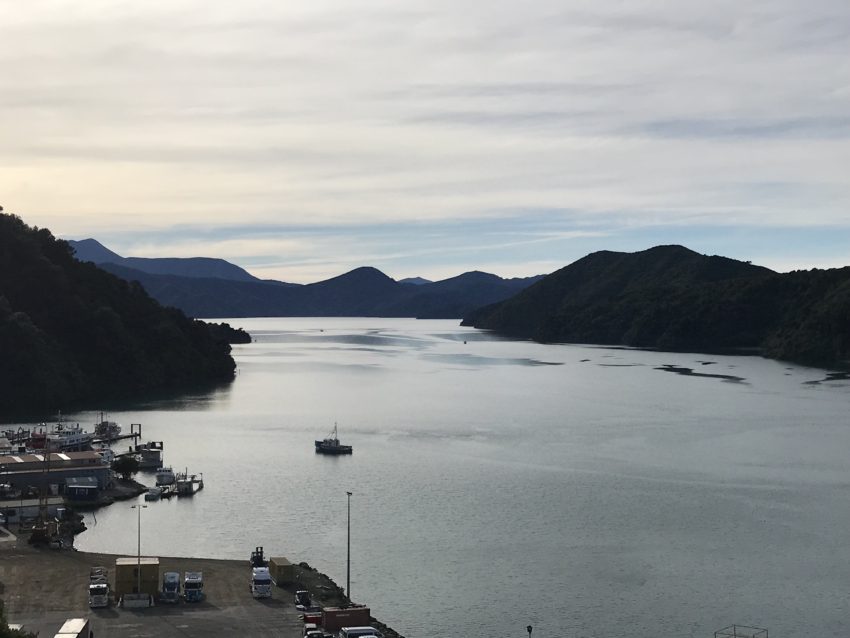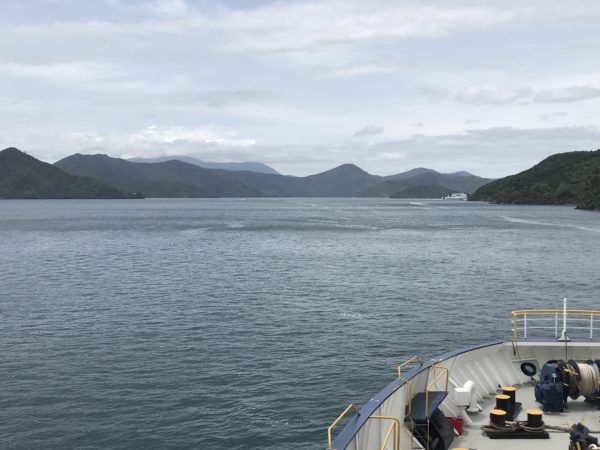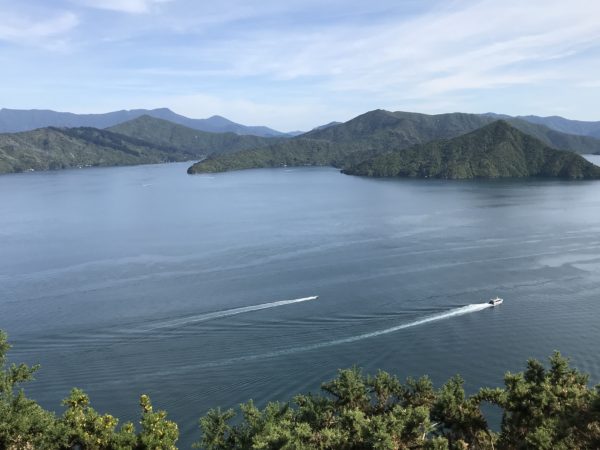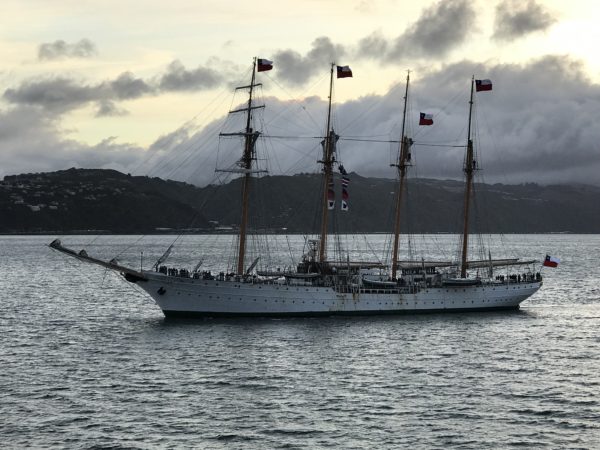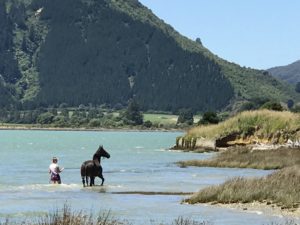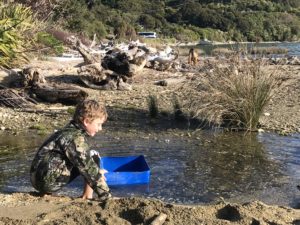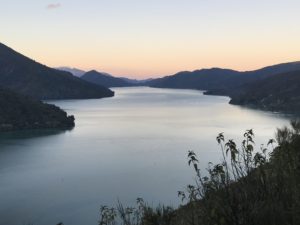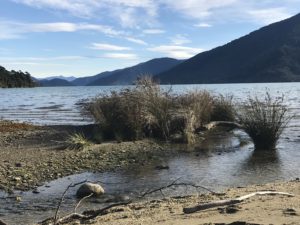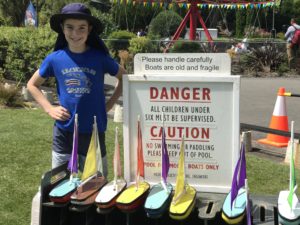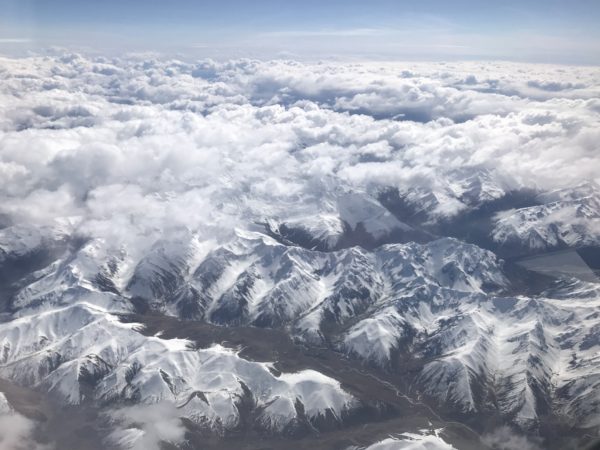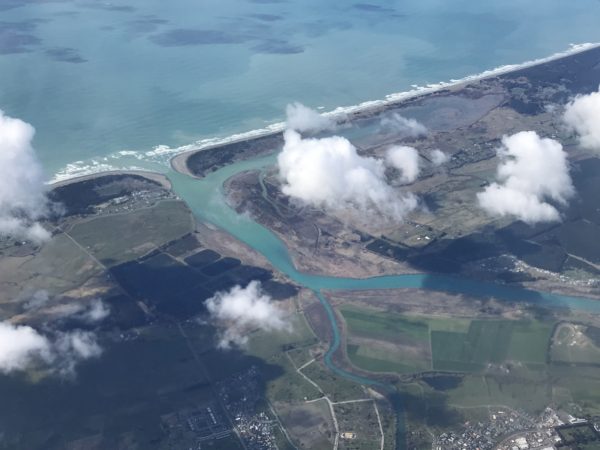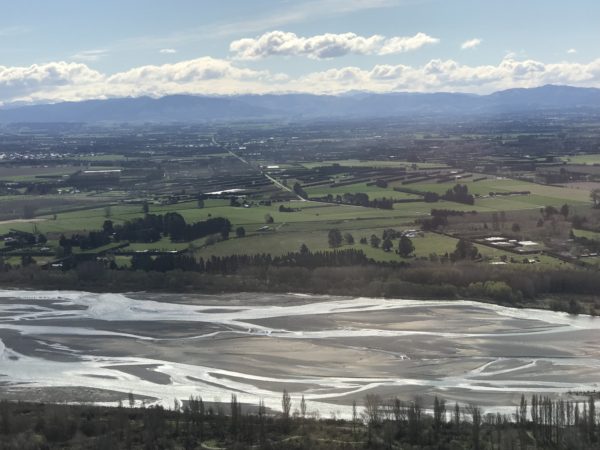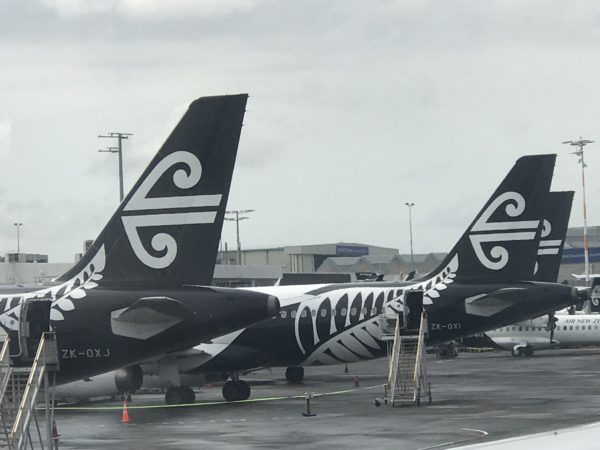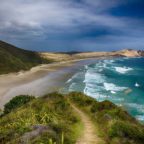Wondering about your options to get between the North and South Islands of New Zealand?
This post covers the options you’ll have for inter-island travel and their pros and cons.
Getting there
If you’re on a budget or transporting a vehicle across, you’ll take a ferry between the main North and South Islands of New Zealand.
Ferries
Since we travelled down south last year in a motor home, we crossed the Cook Strait (the water between the north and south islands) by ferry.
There are two companies offering a Cook Strait ferry service between Wellington (north) and Picton (south) – Bluebridge and The Interislander.
Both provide passenger and vehicle transport and a range of travel times and refreshments. 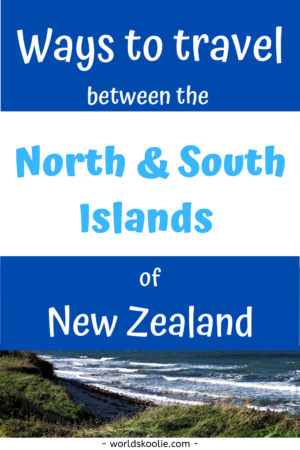
Bluebridge
We crossed with Bluebridge in July and again in December as they were cheaper for our two vehicles and family of four.
We got a great discount through the NZMCA (up to 50%) with full ticket flexibility so we could change our plans before each crossing. Bluebridge also offer Airpoints Dollars rewards.
Adult foot passengers can cross for under $50 and kids around $25, with under 2s travelling free.
Vehicles are charged based on type (car, van, truck etc.), length, and number of passengers included.
They also offer a choice of single, double, twin and family cabins complete with linen if you’d prefer to rest in comfort or sleep during the crossing.
Regardless of when your booking is made, off-peak rates will apply for travel from 16 January to 14 December and peak rates will apply for travel from 15 December to 15 January but there are student rates for those that qualify.
You can check out their fare types and pricing here.
We made our booking online and were emailed a booking confirmation sheet which was handy to have when checking in but you can just give your booking number on check-in if you don’t have your booking form, it just takes longer.
We camped overnight in the Evan’s Bay freedom camp on Oriental Parade. From there access to the ferry terminal at the port was easy and traffic-free.
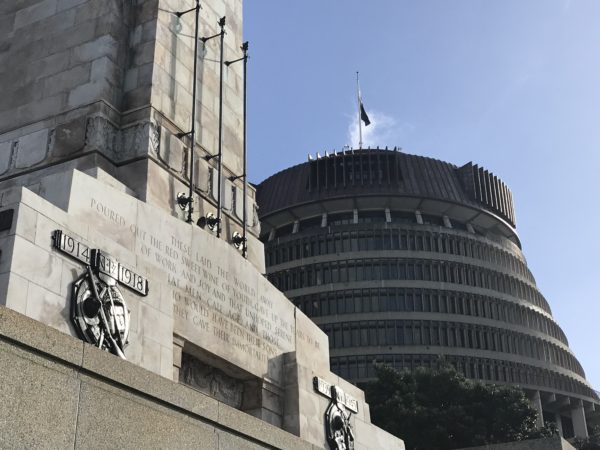
As per the booking paperwork, we arrived an hour prior to sailing and sat in our vehicle in the queue to board.
Once we passed through the check-in kiosk we were directed where to move to await boarding.
There were no delays and we drove into the boat well before our 8 am departure time. There were crew directing vehicles so the process was smooth and clear.
The decks had lanes marked making it easy to line up and vehicles park close to each other nose to nose.
You have to leave your vehicle on deck 3 and head to a passenger area on deck 4 for the duration of the crossing.
There were cars coming in and parking so you have to stay alert as you cross deck 3 for the exit doors. There’s a small lift up to deck 4 for those that need it but we took the stairs.
Note that the doors to the vehicle decks get locked so take all you need up with you.
WiFi and kids entertainment (in a dedicated kids’ room) plus freebie activity packs for those who wanted them are provided free on Bluebridge crossings.
Movies like the B.F.G or The Greatest Showman screen for free too in a separate cinema room during crossings and you can fit in one plus a half of the next movie during the usual 3.5-hour journey.
There are plenty of windows and chairs scattered around plus USB and power plugs for charging devices on board. I used the WiFi and it was good but my phone was pretty flat so mostly it was just on charge.
There is only one main passenger area but you do have access to the outer deck so you can view the changing scenery, which is pretty staggering through the Marlborough Sounds as you head into Picton.
Depending on how rough and windy it is, this can be a great way to while away the crossing time. On the day we crossed, it was wet and windy so it was hard to stand or walk steadily even along the internal passageways due to the rough seas and we spent most of our time inside.
If you’re feeling seasick though the fresh air and watching the horizon can help, weather permitting.
If you’re hungry, a cafe opens up soon after departure and serves a range of food options from sandwiches to meals with salads and hot chips.
We found them pricey for a family ($6 for one cup of hot chips). We took our own drinks and snacks to nibble on but the cafe’s convenient if you want something like a hot drink during the journey.
On docking in Picton, passengers bunched up at the stairwell to head down to the vehicles. After that, the trip off the boat was easy and quick.
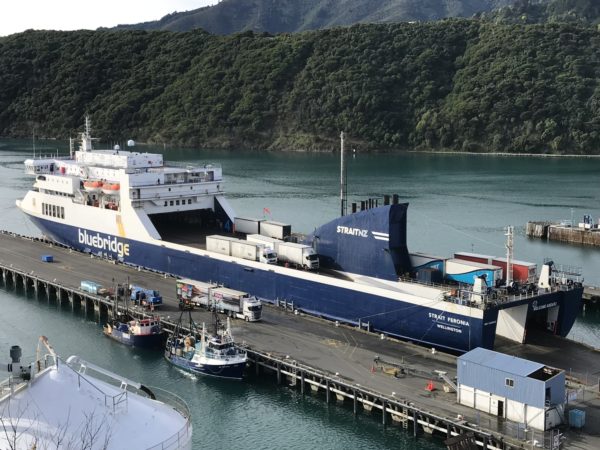
Most of our deck was cars and motor homes. The transport trucks were separated on another floor.
I’d say that the ferry was in overall good condition, offered a range of things, and was spacious. And that service was good. I’d travel with them again.
And the Marlborough Sounds are nothing short of spectacular. We loved the time we got to spend exploring there.
The second time we crossed with Bluebridge, on a 2pm crossing from Picton in late December, was calm and hassle-free.
The wait in Picton was pleasant with plenty to see. We had an afternoon crossing so we walked the Snout Track in the morning as far as the Queen Charlotte View Lookout.
Before heading to check-in, we spent a little time browsing Picton’s shops, eating fresh fruit ice-cream, and playing down at the waterfront.
There’s a great ship playground there as well as a miniature train and sailing boat pond. You can hire a sailboat for 20c with no time limit!
A ferry upgrade for this crossing was a face painter in the kid’s entertainment zone doing amazing face art for free!
Boarding was once again easy though the wait queuing in vehicles was longer than in Wellington.
As the weather was nicer this time, photography opportunities on the way were improved and we spent more time out on the front deck watching the spectacular scenery glide by.
We had no delays and zapped off the boat in Wellington around 5.30 pm as scheduled. My recommendation is that if you cross at this time and haven’t eaten on board, that you stop nearby and feed yourself as there are tons of eateries in town.
And lastly, as there are heaps of one-way roads around Wellington, to save frustration, use Google Maps to get you to your chosen destination quickest.
Interislander
These boats are larger and often sail in rougher weather. The slightly superior interior space and comfort of these boats may be irrelevant if you pass your time on the outside deck.
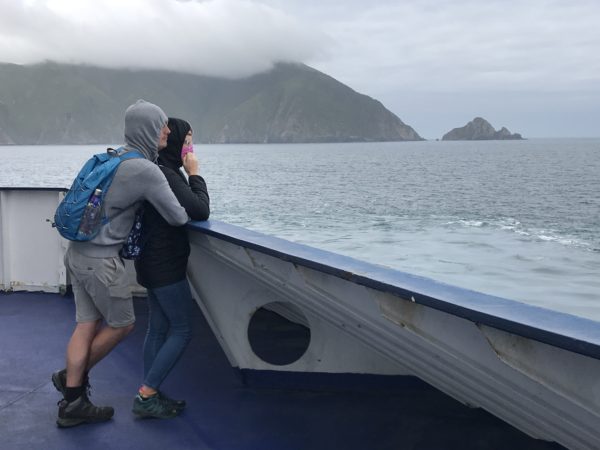
They offer discounts for seniors, events and families. Their prices tend to be higher but can vary so it’s best to compare when booking anyway.
This was the first ferry I crossed the Strait in as it has been running for over 40 years and was the only company running between the two islands at the time.
I was a foot passenger and it was large and spacious and offered a range of sailing times. The day time sailing was a winner as the scenery is so beautiful.
They take bikes and vehicles too and journey duration is roughly the same.
An adult ticket for a one-way crossing at the time of writing was $56 with flexible fares costing from $75.
I recommend ferry travel if this is your first or only time crossing between the islands of NZ as the trip is so scenic, especially through the Marlborough Sounds. If you can, choose a calm day to cross as it’s less pleasant in tumultuous seas.
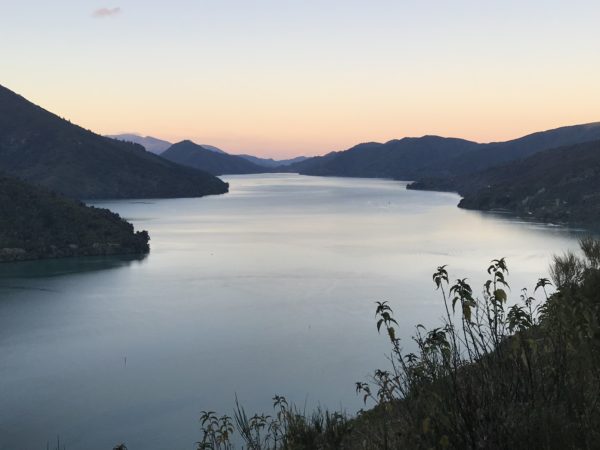
Planes
If you want to travel faster between places then flying is the way to go. Travelling by air saves time as the ferry journey consumes about 3.5 hours of your day.
It’s also really scenic on a clear day.
Flying can be more costly than driving or ferry travel but if you book in advance or grab a flight deal you’ll probably end up better off financially.
Several airlines in NZ offer last minute, standby or cheap seats on flights months in advance so bargains can be got for less than the petrol it would take to get you there by car and a ferry ticket.
Say you were driving a rental car that’s less than 5.5 m in length… For one adult plus the car, your ferry crossing alone would be about $175 one way. The bonus, however, of taking a car is that you have the immediate use of it when you get there.
Cars
If you are going to rent a car in NZ, be aware that some of the larger car rental companies do not allow their cars to be taken on a ferry from one island to the other often due to marine insurance limitations.
As a rule of thumb, the major car hire companies (Hertz, Avis, Budget, Thrifty) don’t allow you to take your car on the ferry, and you have to leave it in Wellington, walk on, and collect another in Picton.
This makes the crossing a little cheaper, and the car hire companies don’t charge you for separate rentals as they treat it as a single hire.
If I were planning a car rental, I’d be checking the companies above plus Apex, Ace, and Go Rentals. Car rental comparisons for NZ can be done on sites like Vroomvroomvroom.
Rental relocations could be something you’d want to look into too for getting from one place to another within or between islands (often free) if you don’t mind working to their time deadlines. Several companies like Transfercar do cars and campervans across New Zealand.
Costs
An adult foot passenger on a ferry would cost around $56 one way.
A plane ticket, however, goes for as little as $38 one way and that could get you between a range of large cities across NZ like Auckland, Christchurch, Dunedin, Invercargill, or Whangarei.
I flew Christchurch to Auckland return for around $100. The view was really scenic out of my window seat and I even got an in-flight snack after an easy digital scan check-in.
The two major airports in NZ are Auckland in the North Island and Christchurch in the South.
Most international flights arrive in Auckland, though flights from Australia fly into other key airports like Rotorua, Dunedin, Queenstown, or Wellington as well so if you are flying to New Zealand via Australia, you might have the option to fly directly to the South Island.
There are domestic flights between all major towns in NZ and they’re often easier to find than flights to smaller towns.
Let’s look at some inter-island connections.
Flying between islands in NZ
Typically if you’re flying between the North and South Islands, you’ll fly from Wellington in the north to Blenheim (30mins) or Nelson (45 mins) at the top of the South Island.
Or from Auckland to Blenheim or Nelson which takes about 1h 30m to either.
Alternatively, you could fly Auckland to Christchurch which will take approximately an hour and 15 minutes.
Christchurch is a great city to fly into. The airport is modern and clean and well serviced and near several amenities within a short distance.
Plus things like rental car and motor home companies are in good supply as it’s the largest South Island city.
Of course, buying your ticket early usually saves you money as a last-minute ticket between Auckland and Christchurch could start from $109.
Bear in mind that Fri, Sat, and Sunday flights often cost more and you’ll need to consider the cost and time involved in airport transfers.
The top domestic NZ routes and their approximate flight times are as follows:
| From | To | Time |
| Auckland | Christchurch | 1 hour 25 minutes |
| Auckland | Wellington | 1 hour 5 minutes |
| Wellington | Christchurch | 55 minutes |
| Auckland | Queenstown | 1 hour 50 minutes |
| Auckland | Nelson | 1 hour 25 minutes |
| Auckland | Napier | 1 hour |
| Auckland | Palmerston North | 1 hour 10 minutes |
Top tip: If I were planning a flight to or within NZ, these are the sites I’d be checking:
Some airlines like Air New Zealand offer Airpoints programmes so take advantage of those too if you can.
Deciding
Whether you want to travel one way or do a loop, eventually, if you want to see both islands, you’ll have to cross the Cook Strait.
Fly or ferry north to south or vice versa?
It’s up to you, depending on the time and money you have available and whether you want a sea or aerial view for the Cook Strait crossing.
I’ve aimed to highlight a few pros and cons, tips, and insights for each way to cross between New Zealand’s two main islands.
Have you got any other tips or experience about inter-island travel in New Zealand?
Please share it with us in the comments below.
Please also click on one of these images to pin this post.
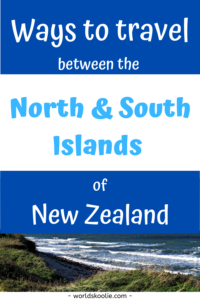
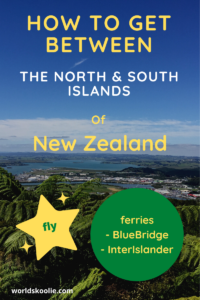
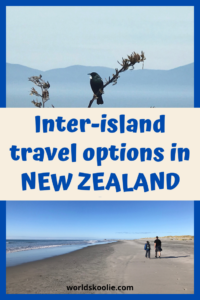
Happy travels!

Meagan

